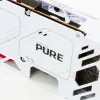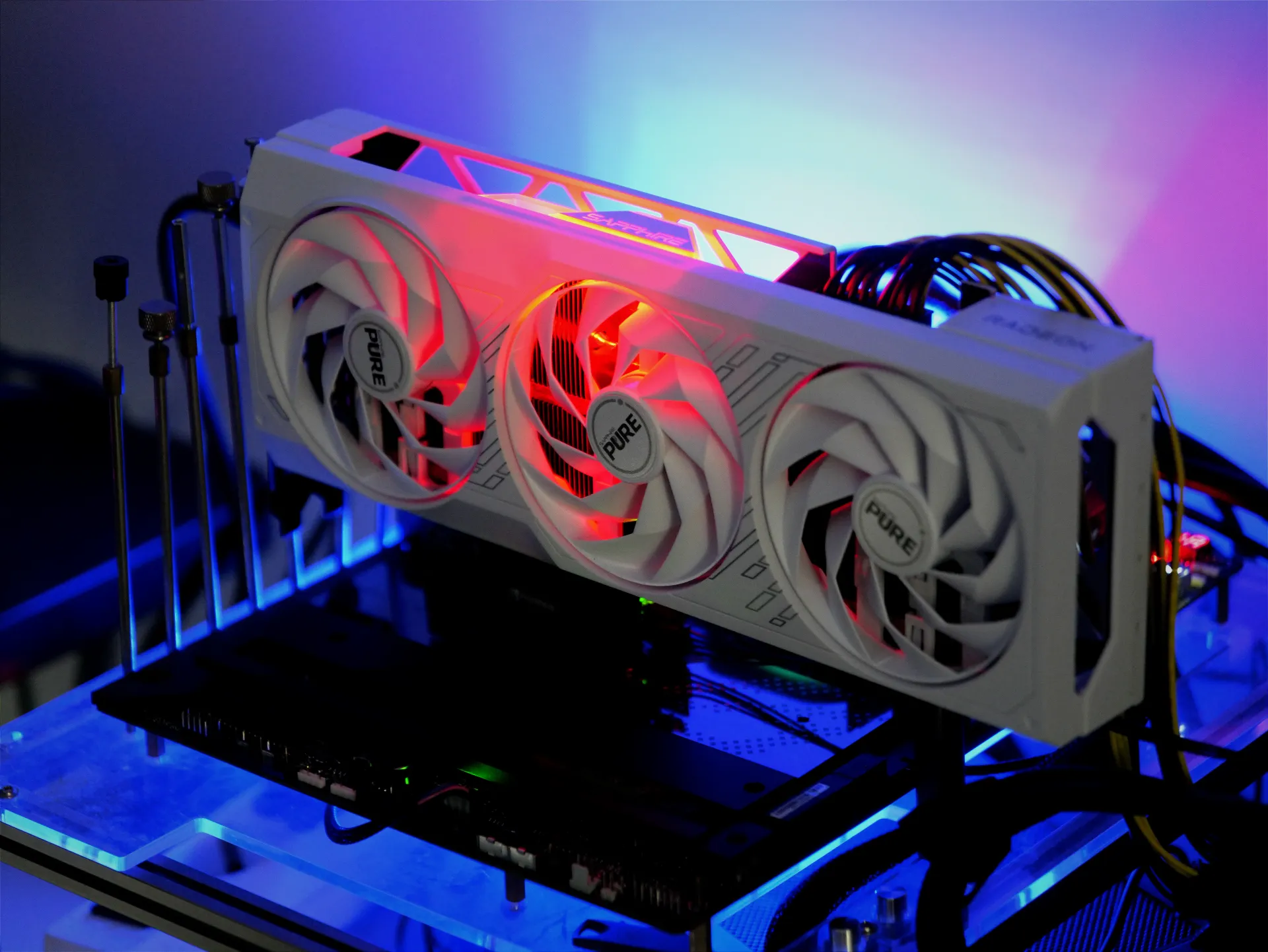Introduction Sapphire Pure Radeon RX 7700 XT 12GB Gaming OC
Sapphire's RX 7700 XT PURE has been positioned in the market to bridge the gap between the Pulse series and the higher-end Nitro+ series. This graphics card is overclocked and distinct from the Pulse series with the addition of a third cooling fan and an enlarged heatsink. The model marks a departure from Sapphire's traditional color schemes by adopting an all-white color palette, aligning with the trend for white components in PC builds.
The RX 7700 XT PURE not only ventures into new aesthetic territory but also introduces the Navi 32 silicon, a chiplet-based GPU that follows the design principles of the Navi 31, which is used in the RX 7900 series. The Navi 32 maintains a slightly reduced configuration and incorporates AMD's strategy of separating components that do not significantly benefit from a 5 nm manufacturing process. Instead, these components are placed onto 6 nm chiplets. Such components include the Infinity Cache and GDDR6 memory controllers, which reside on what are known as memory cache dies (MCDs). The MCDs house both a 16 MB segment of the Infinity Cache and a 64-bit segment of the 256-bit GDDR6 memory interface, while the core computational and graphics processing is handled by the 5 nm graphics compute die (GCD).
Such features position the GPUs to notably influence the WQHD monitor resolution segment. However, premium performance comes with a price: the 7700 XT is priced at $449, while the 7800 XT begins at $499. For our assessment, we will be examining the 12GB 7700 XT from ASUS as they shipped in the TUG Gaming OC edition. For a while now, rumours have been flooding the graphics card arena, and as so often, most of them become an actuality. Meet the new Navi 32-based GPU models. The Radeon 7800 XT with its 16GB 256-bit memory configuration at 19.5 Gbps, is bound to impress. This particular iteration is poised to utilize the complete 60 CU / 3840 Shader processors setup of the GPU and boasts a Total Board Power (TBP) of 263W. The AMD Radeon RX 7800 XT GPU is built upon the Navi 32 SKU framework and thus chiplets, incorporating four Memory Controller Domains (MCDs). The GPU core boasts 3840 cores, meticulously distributed across 60 Compute Units to enhance performance. Additionally, the GPU incorporates a substantial 64 MB Infinity Cache, functioning at an 18 Gbps pin speed, thereby yielding a commendable total bandwidth of 576 GB/s. The second Navi 32 variant, aka Radeon RX 7700 XT, sees a friendly 54 CU/3456 shader processor configuration, complemented by 12GB memory on a 192-bit bus running at an effective 18 Gbps data rate. This points towards a Navi 32 iteration with one of the four MCDs disabled, resulting in 48 MB of Infinity Cache. The core setup of the RX 7700 XT is anticipated to encompass approximately 54 Compute Units, housing a total of 3456 stream processors.
| AMD Radeon RX 7000 Specifications | |||||
|---|---|---|---|---|---|
| Radeon RX | 7900XTX | 7900 XT | 7800 XT | 7700 XT | 7600 |
| Architecture | RDNA3 (TSMC N5) | RDNA3 (TSMC N5) | RDNA3 (TSMC N6) | RDNA3 (TSMC N6) | RDNA3 (TSMC N6) |
| GPU | Navi 31 XTX | Navi 31 XT | Navi 32 XL | Navi 32 XT | Navi 33 |
| GPU Clusters | 96 CUs | 84 CUs | 60 CUs | 54 CUs | 32 CUs |
| FP32 Cores | 6144 | 5376 | 3840 | 3456 | 2048 |
| Game Clock | 2.3 GHz | 2.0 GHz | 2.124 GHz | 2.171 GHz | 2.25 GHz |
| Boost Clock | 2.5 GHz | 2.4 GHz | 2.43 GHz | 2.54 | 2.625 GHz |
| Memory | 24GB G6 | 20GB G6 | 16GB G6 | 12 GB G6 | 8GB G6 |
| Memory Bus | 384-bit | 320-bit | 256-bit | 192-bit | 128-bit |
| Memory Speed | 20 Gbps | 20 Gbps | 19.5 Gbps | 18 Gbps | 18 Gbps |
| L3 Cache | 96 MB | 80 MB | 64 MB Gen2 | 48MB Gen2 | 32 MB Gen2 |
| Board Power | 355W | 315W | 263W | 245W | 165W |
| Power Connectors | 2 × 8-pin | 2 × 8-pin | 2 × 8-pin | 2 × 8-pin | 1 x 8-pin |
| PCIe Interface | Gen4 x16 | Gen4 x16 | Gen4 x16 | Gen4 x16 | Gen4 x8 |
| MSRP | $999 | $899 | $489 | $449 | $269 |
| Launch Date | December 2022 | December 2022 | September 2023 | September 2023 | May 2023 |
The Sapphire Radeon RX 7700 XT Pure stands apart from its counterpart, the RX 7700 XT Pulse. The key distinction lies in the physical dimensions and cooling configuration. While the Pulse model features a 28 cm long cooler with two fans, the Pure extends to 32 cm in length and incorporates three fans. In terms of aesthetics, the card's paint job is defined by the cooler shroud, fan impellers, and backplate, while the PCB beneath remains black. Sapphire officially lists a $469 MSRP for the Pure variant, which is $20 higher than the base RX 7700 XT price. This price difference essentially accounts for the change in aesthetics, along with the inclusion of red lighting. It's important to note that there is no RGB lighting; instead, Sapphire offers a red backlit logo. Regarding the performance, the Pure model exhibits a slight improvement over a reference card. It features a modest overclock and offers efficient cooling solutions. This makes it a viable choice for those seeking enhanced performance and thermal management without venturing into extravagant territory. Sapphire has also chosen has upped the clock frequency for the 'OC' SKU, peaking to 2584 MHz for its (dynamic) Boost clockf requency.


